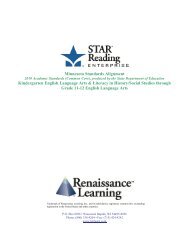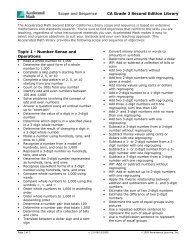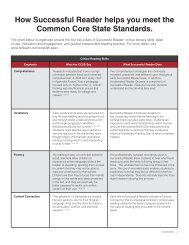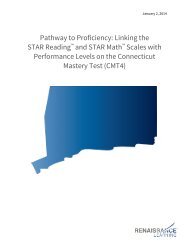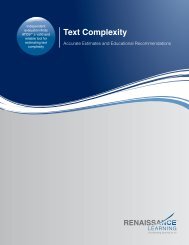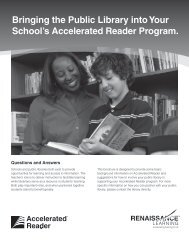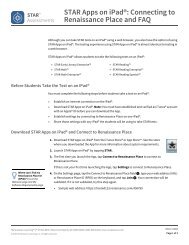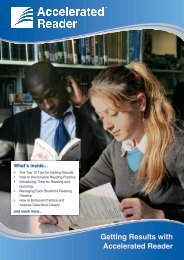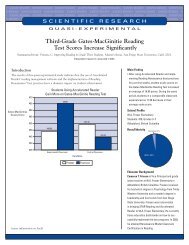Technical Manual - Renaissance Learning
Technical Manual - Renaissance Learning
Technical Manual - Renaissance Learning
You also want an ePaper? Increase the reach of your titles
YUMPU automatically turns print PDFs into web optimized ePapers that Google loves.
Content and Item DevelopmentItem Development: STAR Early Literacy EnterpriseThe design of items for new skills followed this process:Research into current practice and theory was undertaken.An expert with an assessment background in early literacy was engaged toprovide guidance on the development.The Media team provided input on the wording of scripts to ensureconsistency with other items in the product.After new items were created, they went through the calibration process, afterwhich they were analyzed for their effectiveness by psychometricians and theContent team.Text of Scripts/Audio InstructionsBlending parts of 2- or 3- syllable words (as in PA03) or Phoneme Segmentation (asin PA09) or Syllabification (SA02):1. Each word will first be pronounced as shown in the pronunciation guide in thedictionary.2. For the purpose of demonstrating blending of syllables or syllablesegmentation, words will be pronounced using the word breaks given in thedictionary, not the pronunciation guides.3. The sounds themselves will be pronounced as closely as is possible to the waythe sounds are heard in the word.Retain the accent(s) of the word (not all syllables will be equallyaccented).A vowel in an unaccented syllable makes the schwa sound. Use thatpronunciation in saying the whole word. However, when saying the soundwithin the syllable, use something a little closer to the short vowel sound(using Ehri’s correctionist theory of word learning, 1998). A separatedocument on the research on syllabification is being prepared as of thiswriting.The audio should ensure that the sounds are correctly pronounced andnot turned into nonexistent syllables (not muh but mmm).4. In blending the sounds in the word (“mmmmmmmaaaaaaaaannnnnnnn”). Donot stop between the sounds. Make certain that the sounds are not distortedas you stretch them out. Hold each sound long enough for the students tohear it individually. Stop sounds cannot be prolonged without distortion.When pronouncing words that begin with stop sounds (such as t, k, and p),pronounce the initial sound quickly and do not stretch it out. Clip the sound ofa consonant stop sound at the end of a word.STAR Early Literacy<strong>Technical</strong> <strong>Manual</strong>34





